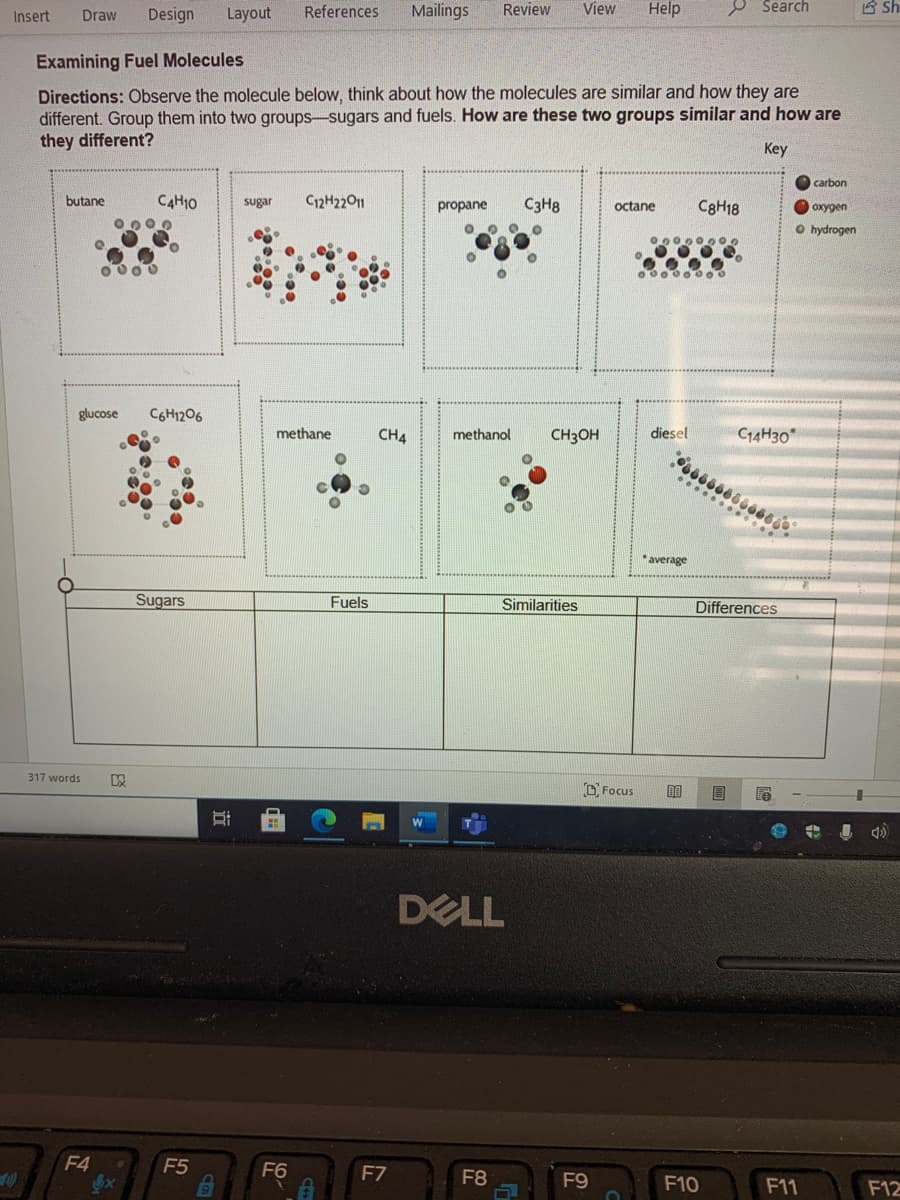Design Layout References Mailings Review View Help P Search Insert Draw Examining Fuel Molecules Directions: Observe the molecule below, think about how the molecules are similar and how they are different. Group them into two groups-sugars and fuels. How are these two groups similar and how are they different? Key carbon butane CAH10 sugar C12H22011 propane C3H8 CgH18 octane oxygen O hydrogen glucose C6H1206 methane CH4 methanol CH3OH diesel C14H30 average Sugars Fuels Similarities Differences
Design Layout References Mailings Review View Help P Search Insert Draw Examining Fuel Molecules Directions: Observe the molecule below, think about how the molecules are similar and how they are different. Group them into two groups-sugars and fuels. How are these two groups similar and how are they different? Key carbon butane CAH10 sugar C12H22011 propane C3H8 CgH18 octane oxygen O hydrogen glucose C6H1206 methane CH4 methanol CH3OH diesel C14H30 average Sugars Fuels Similarities Differences
Introductory Chemistry: An Active Learning Approach
6th Edition
ISBN:9781305079250
Author:Mark S. Cracolice, Ed Peters
Publisher:Mark S. Cracolice, Ed Peters
Chapter22: Biochemistry
Section: Chapter Questions
Problem 33E
Related questions
Question
Please help I need to fill in the last row of boxes

Transcribed Image Text:Design
Layout
References
Mailings
Review
View
Help
P Search
E sh
Insert
Draw
Examining Fuel Molecules
Directions: Observe the molecule below, think about how the molecules are similar and how they are
different. Group them into two groups-sugars and fuels. How are these two groups similar and how are
they different?
Key
carbon
butane
CAH10
C12H22011
C3H8
sugar
propane
octane
CaH18
oxygen
O hydrogen
O000
glucose
C6H1206
methane
CH4
methanol
CH3OH
diesel
C14H30
*average
Sugars
Fuels
Similarities
Differences
317 words
O Focus
DELL
F4
Ix
F5
F6
F7
F8
F9
F10
F11
F12
Expert Solution
This question has been solved!
Explore an expertly crafted, step-by-step solution for a thorough understanding of key concepts.
Step by step
Solved in 3 steps

Knowledge Booster
Learn more about
Need a deep-dive on the concept behind this application? Look no further. Learn more about this topic, chemistry and related others by exploring similar questions and additional content below.Recommended textbooks for you

Introductory Chemistry: An Active Learning Approa…
Chemistry
ISBN:
9781305079250
Author:
Mark S. Cracolice, Ed Peters
Publisher:
Cengage Learning

World of Chemistry
Chemistry
ISBN:
9780618562763
Author:
Steven S. Zumdahl
Publisher:
Houghton Mifflin College Div

World of Chemistry, 3rd edition
Chemistry
ISBN:
9781133109655
Author:
Steven S. Zumdahl, Susan L. Zumdahl, Donald J. DeCoste
Publisher:
Brooks / Cole / Cengage Learning

Introductory Chemistry: An Active Learning Approa…
Chemistry
ISBN:
9781305079250
Author:
Mark S. Cracolice, Ed Peters
Publisher:
Cengage Learning

World of Chemistry
Chemistry
ISBN:
9780618562763
Author:
Steven S. Zumdahl
Publisher:
Houghton Mifflin College Div

World of Chemistry, 3rd edition
Chemistry
ISBN:
9781133109655
Author:
Steven S. Zumdahl, Susan L. Zumdahl, Donald J. DeCoste
Publisher:
Brooks / Cole / Cengage Learning

Chemistry: Principles and Reactions
Chemistry
ISBN:
9781305079373
Author:
William L. Masterton, Cecile N. Hurley
Publisher:
Cengage Learning

Chemistry: Matter and Change
Chemistry
ISBN:
9780078746376
Author:
Dinah Zike, Laurel Dingrando, Nicholas Hainen, Cheryl Wistrom
Publisher:
Glencoe/McGraw-Hill School Pub Co

Introductory Chemistry: A Foundation
Chemistry
ISBN:
9781337399425
Author:
Steven S. Zumdahl, Donald J. DeCoste
Publisher:
Cengage Learning